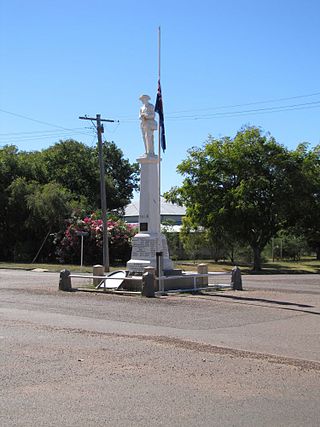
Aramac is a rural town and locality in the Barcaldine Region, Queensland, Australia. In the 2021 census, the locality of Aramac had a population of 372 people.

Jericho is a rural town and locality in the Barcaldine Region, Queensland, Australia. In the 2021 census, the locality of Jericho had a population of 229 people.

The Barcaldine Region is a local government area in Central West Queensland, Australia. Established in 2008, it was preceded by three previous local government areas which had existed for over a century.

Cornish Creek is a former rural locality in the Barcaldine Region, Queensland, Australia. In the 2016 census, Cornish Creek had a population of 16 people.
Bangall is a former rural locality in the Barcaldine Region, Queensland, Australia. In the 2016 census, Bangall had a population of 4 people.
Ingberry is a former rural locality in the Barcaldine Region, Queensland, Australia. In the 2016 census, Ingberry had a population of 11 people.
Ibis is a former rural locality in the Barcaldine Region, Queensland, Australia. In the 2016 census, Ibis had a population of 4 people.
Sardine is a former rural locality in the Barcaldine Region, Queensland, Australia. In the 2016 census, Sardine had a population of 5 people.
Evora is a former rural locality in the Barcaldine Region, Queensland, Australia. In the 2016 census, Evora had a population of 0 people.
Grant is a former rural locality in the Barcaldine Region, Queensland, Australia. In the 2016 census, Grant had a population of 11 people.

Saltern Creek is a former rural locality in the Barcaldine Region, Queensland, Australia. In the 2016 census, Saltern Creek had a population of 12 people.
Tara Station is a former rural locality in the Barcaldine Region, Queensland, Australia. In the 2016 census, Tara Station had a population of 10 people.
Beaufort is a former rural locality in the Barcaldine Region, Queensland, Australia. In the 2016 census, Beaufort had a population of 46 people. On 22 November 2019 the Queensland Government decided to amalgamate the localities in the Barcaldine Region, resulting in five expanded localities based on the larger towns: Alpha, Aramac, Barcaldine, Jericho and Muttaburra. Beaufort was incorporated into Alpha.
Drummondslope is a former rural locality in the Barcaldine Region, Queensland, Australia. In the 2016 census, Drummondslope had a population of 43 people. On 22 November 2019 the Queensland Government decided to amalgamate the localities in the Barcaldine Region, resulting in five expanded localities based on the larger towns: Alpha, Aramac, Barcaldine, Jericho and Muttaburra. Drummondslope was incorporated into Alpha.
Garfield is a former rural locality in the Barcaldine Region, Queensland, Australia. In the 2016 census, Garfield had a population of 37 people.

Hobartville is a former rural locality in the Barcaldine Region, Queensland, Australia. In the 2016 census, Hobartville had a population of 50 people.
Mexico is a former rural locality in the Barcaldine Region, Queensland, Australia. In the 2016 census, Mexico had a population of 26 people.
Port Wine is a former rural locality in the Barcaldine Region, Queensland, Australia. In the 2016 census, Port Wine had a population of 27 people.
Sedgeford is a former rural locality in the Barcaldine Region, Queensland, Australia. In the 2016 census, Sedgeford had a population of 0 people.

Surbiton is a former rural locality in the Barcaldine Region, Queensland, Australia. In the 2016 census, Surbiton had a population of 80 people.










